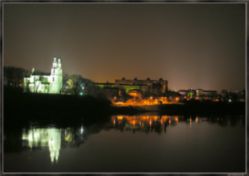Polotsk: History

The first written mentioning of Polotsk dates back to 862. Located on the route from the Variangians to the Greeks Polotsk became capital of one of the largest European principalities and managed to maintain its significance for almost one millennium. The peer and rival of Kiev and Novgorod, Polotsk was equally famous. The names of its legendary rulers Rogvolod and Vseslav, Princes Ragneda and her son Izyaslav were known everywhere in the immense Empire of the Rurikoviches.
Polotsk is renowned not only as the cradle of the Belarusian statehood but also as the trading center with merchants flocking from all over the West and East to trade there. Favourable geographic position, various waterways and land trade routes passing via the town fostered its rapid growth and economic development. The 16th-century emblem of Polotsk, featuring a ship swaying on silver waves against the azure background, bears testimony to the abundance of waterways in Polotsk. In the 12th century an original architectural style of Polotsk was developed.
Great enlightener of Belarus, Euphrosyne of Polotsk, lived there. She founded two churches, several convents and monasteries which became centers of enlightenment in the Principality of Polotsk. A monument to Euphrosyne was erected in the Polotsk downtown.
Today Polotsk is an industrial and cultural hub, one of the most beautiful cities of Belarus with more than 80,000 inhabitants and about 30 private and state-run manufactures.
The town has about 130 historical, cultural and architectural sights.
The oldest building of Polotsk is St. Sophia Cathedral (11th century), a symbol of independence and power of the Polotsk land.
Euphrosyne of Polotsk was buried in the Church of Our Savior and Transfiguration (12th century) located on the territory of the ancient St. Euphrosyne’s Convent (built in 1125). The convent and the church are considered to be the rarest surviving specimen of the ancient Slavic architecture and painting. The Cathedral of Exhaltation of the Holy Cross (the 19th century) keeps a replica of the famous cross made by Lazar Bogsha on Euphrosyne’s order in 1161. The cross was lost during WWII and recreated in 1997.
The other sights of Polotsk are Upper and Lower Castles with Ivan the Terrible’s wall, the former Epiphany Convent, the house of Peter I, the town hall, the governor’s residence, Jesuit collegium.
Похожие страницы :
| Polotsk: Hotels |
| Polotsk war museum |
| Polotsk: Shops |
| Polotsk: Tourist routes |












